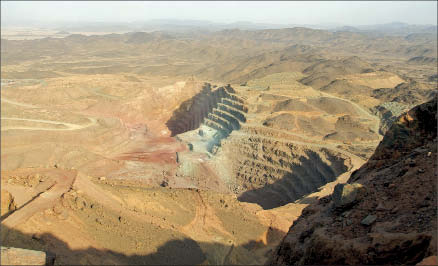For the past six years, Martin Amyot has been making an annual trek to Vancouver to try to convince investors that not only has Sudan had a gold mine in continuous operation since 1991, but also that the mine will be in operation for years to come.
It hasn’t been an easy sell given the country’s turbulent past, but as senior vice-president of La Mancha Resources (LMA-T), part of Amyot’s job is to dispel the skepticism. Fortunately the facts back up his case, and the Hassai mine continues to operate uninterrupted, now with about 2.2 million oz. in gold production to its name.
Geographically, the mine benefits from its location 450 km northeast of Khartoum, 130 km east of the Nile and a good 1,200 km from South Sudan. Being in the middle of nowhere brings with it a level of stability.
Geologically, the mine benefits from being part of the Arabian-Nubian shield that underlies the countries surrounding the Red Sea. The shield is composed of granitoid greenstone belt and mid-crustal gneissic terranes, and is host to numerous volcanogenic massive sulphide and vein gold deposits.
The area saw some of the first gold mining in human history by the ancient Egyptians, and is emerging once again as a significant mining district. Along with La Mancha’s 40%-owned Hassai mine, the area plays host to Centamin Egypt‘s (CEE-T) 9.1-million-reserve-oz.-gold Sukari mine in Egypt, Nevsun Resources‘ (NSU-T) 60%-owned gold-copper-zinc Bisha mine, Sunridge Gold‘s (sgc-v) polymetallic Asmara project and Chalice Gold Mine‘s (CXN-T) Koka gold project – all in Eritrea – and in Saudi Arabia Barrick Gold‘s (ABX-T, ABX-N) Jabal Sayid copper project and several mines run by Saudi state-owned Ma’aden.
With most of those projects still in development or recently put into production, the Hassai mine stands out with its long history. The mine was opened through a joint venture between the Sudanese government and French conglomerate Areva, but in 2006 Areva spun out its gold holdings in Australia, Ivory Coast and Sudan into La Mancha. The Sudanese government holds 56% of the Hassai joint venture, while French shareholders hold 4% and La Mancha the rest.
Up until now the joint-venture partners at Hassai have mined the gold-heavy oxide portion of 16 separate open pits surrounding the main Hassai heap-leach plant and pads, but the oxide ore is running out. La Mancha’s plan is to build a new processing plant and tap into the sulphide deposits that now sit exposed at the bottom of the pits, while also ramping up short-term, phase-one carbon-in-leach plant production.
In the company’s phase two, the shift to sulphides would cost $320 million in capital costs and yield a net present value of $122.7 million using a 5% discount, with US$950 per oz. gold and US$2.19 per lb. copper. Under the plan the company would produce 59,000 oz. gold per year, plus 51,500 tonnes of copper per year for 10 years.
The numbers don’t tell the full story, however. They only incorporate drilling from two of the 16 pits, are based on a 36% first-pass gold recovery that doesn’t incorporate later recovery potential and they don’t include the ramp up of the current carbon-in-leach plant from 0.8 million tonnes a year to 3 million tonnes a year, which should yield 161,647 oz. gold per year for more than four years.
Meanwhile, the company also owns 51% of the Frog’s Leg gold mine and all of the White Foil mine, both in Australia, as well as 45.9% of the Ity mine in Côte d’Ivoire, which combined should produce 94,000 oz. attributable to La Mancha this year.
As a legacy of being spun out of Areva, the French firm still controls 63% of La Mancha, but it is rumoured to be selling the stake for restructuring. Amyot argues that being majority controlled by such a large firm has held back the company’s stock price. With 143 million shares out and $92 million in cash and equivalents on hand, the company’s enterprise value of $258 million – based on a $2.51 stock price on Nov. 21 – takes into account only a third of La Mancha’s extrapolated value for its Australian assets alone, according to the company’s calculations, while its enterprise value to cash flow ratio of 2.2 ranks at a third of the industry average.
That being said, the company was forced to suspend operations at its Côte d’Ivoire mine earlier this year owing to violent unrest following elections. Despite the mine’s stable history, holding a main asset in Sudan brings valuation discounts and risk.
In 2003, for example, Calgary-based Talisman Energy was forced to pull out of the country following intense public pressure regarding Sudan’s poor human rights record.
The situation has improved since a peace deal was signed in 2005 and South Sudan became an independent country earlier this year, but the U.S. retains sanctions on the country, and an arrest warrant from the International Criminal Court is still out for Sudanese President Omar al-Bashir.
It seems that along with sharing a common geology, companies operating in the Arabian-Nubian shield also share the circumstances of working with challenging governments.
The past problems with Sudan are echoed today in neighbouring Eritrea, with the United Nations Security Council having just tightened sanctions on the country. The resolution singled out mining to finance destabilization in the Horn of Africa region and called for greater transparency of how revenues are used, and for all states to introduce due diligence guidelines.
Following the resolution’s passage, Nevsun and Sunridge stated that the sanctions should have no direct impact, but both added that it was not possible to estimate indirect impacts.
Centamin, meanwhile, continues to operate in Egypt despite the political instability. But while production has not been affected, its stock has. It hit a 52-week low of $1.29 after the country’s November protests, having fallen from a $2.91 high before the uprising began in January.


Be the first to comment on "La Mancha planning second life for Hassai"